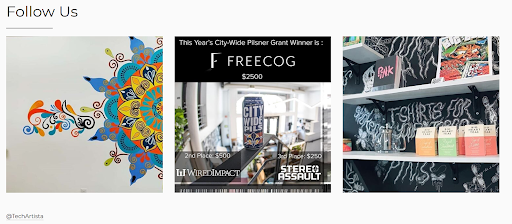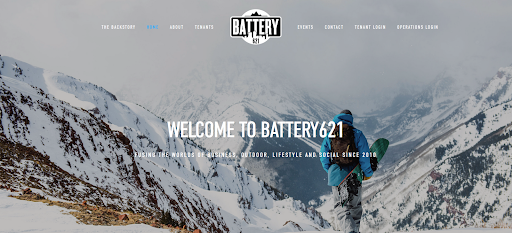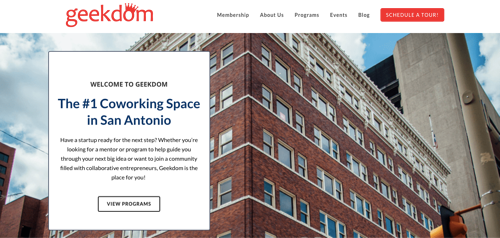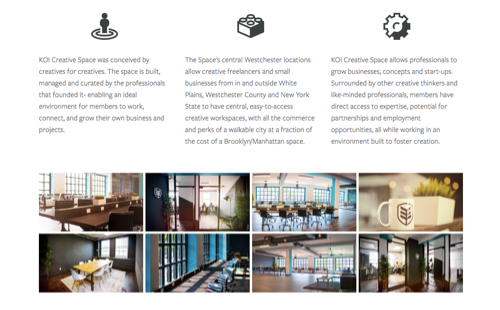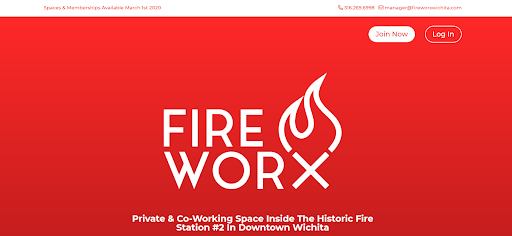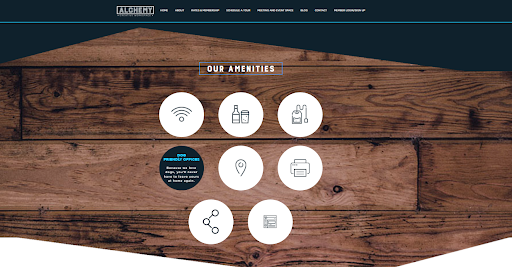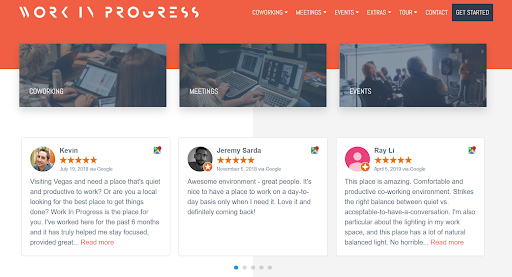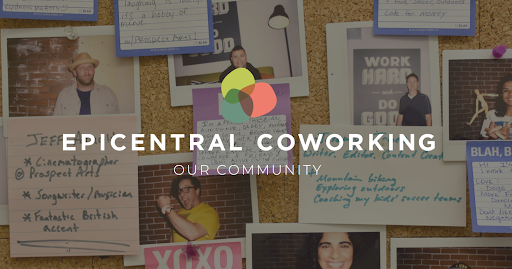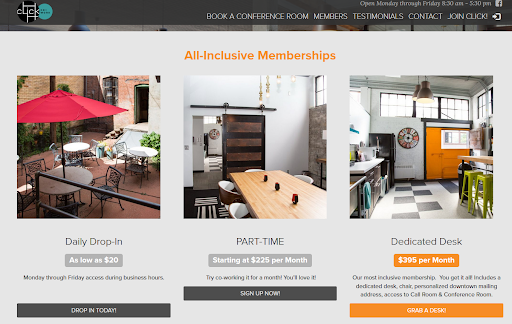Your Coworking Space Website is One of Your Most Important Marketing Tools
You started your coworking space to bring people together as a collaborative community with a foundation based on your unique mission. But to bring them in, prospective members need a doorway. Your coworking space website serves as this doorway to the community you’re creating, and its design should stand as a clear, convincing sign that your members belong.
But you have to be quick to catch their attention.
According to studies, it only takes 50 milliseconds for prospective new members to form an opinion about what that sign conveys. To make a lasting impression on the people visiting your website, here are 11 tips plus examples from the Proximity Network you can use to capture new business and build your member community.
1. Compare Competitors’ Websites and Marketing
By the time potential members schedule a tour or sign up for a membership, they’ve already compared you to your competition. In fact, 81% of consumers reportedly conduct research online before they commit to a service, and selecting coworking spaces is no different.
That’s why the key to creating a coworking space website that inspires and captivates is doing competitive research early on. If you’re in a market with multiple coworking spaces, create a list of the first things you notice about competitors’ websites. If you’re the first coworking space in your area, (yay!) spend some time looking at the websites of spaces you’ve worked from and liked in the past and notice what they do well.
In your research, you’ll pick up some common themes, such as making contact information easily available or listing hours. But you’ll also begin to notice features you can add to make your own website stand out from the crowd.
2. Link Your Coworking Space’s Social Media Accounts
Coworking is inherently social. People want to know what’s happening in their community, and see how the services they’re looking at buying make others successful. That’s why 82% of small businesses use social media to promote themselves.
Show your community what you’re about by linking your active social media accounts to your coworking space website. This can be done by adding buttons to your headers or footers, or by adding widgets to display your most recent posts.
Example: TechArtista in St. Louis, MO
3. Make Sure Your Website Speaks to Your Target Members
The website for your coworking space is your first impression to prospective members. Make sure your values, passion, and mission are clearly communicated to those you want to reach most.
This doesn’t just mean choosing imagery that reflects the industries you support and the community you’re a part of but also requires creating a consistent brand voice across your content. When these factors combine together, it can make a big difference to the 77% of consumers who read online brand content before making a decision.
To do this, look at the values and voices of companies you’d like to partner with to inform what your target audience cares about. Then, translate that into the design and content of your site.
Example: Battery 621 in Denver, CO
4. Identify and Use Relevant Keywords on Your Website
In today’s tech age, search engine optimization (SEO) can make or break your business. In fact, 50.1% of traffic to online businesses comes from organic search.
Make sure you’re the answer your members are searching for when they turn to Google or Bing for the best coworking space around. You can explore the popularity of keywords using a tool like Google Keyword Planner and then add them into page titles and descriptions. As a good rule of thumb, include “coworking [your city]” and keywords around the industries you’re focused on.
Example: Geekdom in San Antonio, TX
5. Keep Your Website Copy Concise and Meaningful
Given 15 minutes to read content, most people prefer to skim a well-designed, concise page of information instead of reading a wall of text. Makes sense, right?
It should be easy for prospective members to figure out what you’re about and find out if your space is a good fit for their needs. Instead of writing an essay about your values and services, break up the text by using images and graphics accompanied by one or two high-impact sentences that sum up your community.
This makes it easy for members to find the information they care about–whether its amenities, hours, or cost–without having to wade through an ocean of text on your website.
Example: FACTORY in Grand Junction, CO
6. Select and Optimize Images to Show Your Coworking Space and Community
Humans are visual creatures. So much so that nearly 40% of people will stop engaging with a website if images take too long to load.
Capture the attention of your website visitors by investing in high-quality photography of your space. If you can’t swing a photo shoot to cover every section of your website, use a handful of shots of your community spaces alongside images from a site like Unsplash that match your brand.
Once you have a batch of awe-inspiring photos, crop them to a uniform size that fits your website design and run them through a service like TinyPNG to reduce file sizes and page load times. Finally, make sure to add meta descriptions to each file that summarize what’s happening in the photo and mentions your coworking space by name.
Example: KOI Creative Space in White Plains, NY
7. Prominently Show the Address and Contact Information for Your Coworking Space
Forty-four percent of web users will leave a website if it’s difficult to find a business’s contact information or phone number.
Make it easy for your prospective members to reach out to you with questions or visit your location by putting the following information above the fold on your website:
- Your address and phone numbers
- A Google-maps enabled link to your address
- One-click calling for mobile visitors
- A prominent call to action (CTA) to contact your space
By making this information easy to find and interact with on your website, you remove friction from the user journey and increase the chances that users will sign up for tours and memberships.
Example: FireWorx in Wichita, KS
8. Use Your Website to Highlight Amenities
Show off what makes your space unique by highlighting the amenities of your coworking space. Whether it’s dog-friendly offices, free kombucha, bike storage, or large conference rooms, these features will help draw in new members.
The best way to showcase your coworking space’s features is by using a series of clean, prominent graphics to represent each. These features shouldn’t be further than one scroll down the homepage of your website.
Example: Alchemy Creative Workspace in Denver, CO
9. Showcase Testimonials from Existing Members
Think about the last time you bought a new product or service. Chances are it took a personal or digital testimonial to make you pull the trigger.
Seventy-two percent of people say positive reviews make them trust a business more. That’s why it’s so important that you put the testimonials you’ve worked hard to earn from your community members on your website.
Get the most out of the praise from your members by adding customer testimonials to your website, either by embedding Google Reviews or by manually selecting the best feedback you’ve received.
Example: Work in Progress in Las Vegas, NV
10. Highlight the Members that Make Up Your Coworking Community
People join coworking spaces for the community. By highlighting the companies and individuals that have already found a home in your space, you preview the kinds of people and businesses new members can expect to work alongside.
When designing your community showcase content, ask for professional photos of your members or have a photographer snap a few headshots. Then, post the photos prominently on your website alongside their names, companies, and their favorite thing about working from your space.
Example: Epicentral Coworking in Colorado Springs, CO
11. Make it Easy for Members to Join
Among all the other tips and tricks for creating a great website, don’t forget the overall goal of your online presence: to make it easy for members to join.
Despite conversions being the end goal for nearly all companies, 70% of small business websites lack a call to action. This makes it difficult–or impossible–for new members to get more information and join your community, no matter how much they love your values and amenities.
To make it easy for visitors to see membership types and sign up from your website, place multiple CTAs on your homepage–and throughout the site and on menu bars–for signing up, contacting the space and scheduling a tour.
Example: Click CO+WORK in Flagstaff, AZ
Leverage Your Website as a Marketing Tool
Building a community around your brand is tough, but a great website and a strong coworking marketing strategy can make a world of difference. Use these 11 website design tips to bring in new members and create a vibrant community for professionals in your city.
If you have questions, or you’re looking for more tools, training, and tips to build your space, the Proximity School of Coworking can help you build business and financial models, draft leases, decide on design and layout, pick amenities, and execute marketing.

